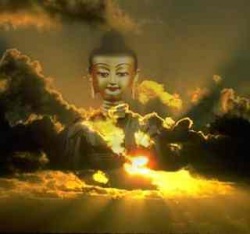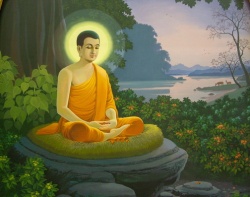Ultimate Reality and Divine Beings
Written by: Julia Hardy
There is no Buddhist story about how the universe was originally created, as the Buddhist universe has no beginning in the sense that the Christian universe does. Early Buddhism shared an understanding of time and the nature of the universe with the Brahmanic religion of the time, which taught that the [[Wikipedia:universe|universe]] had been created and destroyed over and over again over vast periods of time. Within each cycle, there are stages, or kalpas, and the nature of existence is different in each stage. Later Buddhism expanded this vision to include multiple universes, each with its own Buddha and each of which is going through these cycles of creation and destruction.
According to Buddhism, ultimate reality is samsara, endless existence, but it is also impermanent, ever in flux, ever changing. It is empty, yet full. That is, form is always a temporary state of being. Some forms last for millennia, like mountains and oceans, and some are as brief as a lightning bolt. Elements come together to create a particular form, but eventually those elements will break apart again and the object will cease to exist. This is true of everything in the universe.
In contrast to this sophisticated philosophical view of ultimate reality, there are a variety of Buddhist descriptions of the composition of the universe. In one popular description borrowed from Hinduism, figurative rather than literal, there is a mountain, Mount Meru, surrounded by seven concentric circles of land. Outside these lands is a vast ocean, within which are four island continents. Some gods reside in heavens along the slopes of the mountain, or on top. Others reside in heavens above the mountain.
Another view of the universe is often portrayed in Buddhist paintings. Called the bhavacakra, or the Wheel of Life and Death, it depicts the universe as a series of concentric circles all within the grasp of Mara, the lord of death. Several realms for gods of different types and several different hells, as well as an animal realm and a realm for humans, are contained within the wheel.
As Buddhism evolved, the number of realms beyond the earthly realm expanded exponentially. Mahayana Buddhist texts describe many heavenly realms to which people can be reborn, including a number of Pure Lands, each with its own Buddha, as well many horrifying hells.
When Buddhism first began, there were no gods who were recognized as existing outside the realm of rebirth, or to whom one could appeal as saviors. Buddha taught that the gods are not exempt from death and rebirth, and while their lives may last for eons, they do eventually die, and are almost inevitably reborn in a lower realm because the life of a god is too great a distraction from the work that is necessary to achieve enlightenment. The Buddha taught that he was an ordinary man, and he said that those seeking salvation should look within themselves. According to the early texts, his final words were, "All the constituents of being are transitory; work out your salvation with diligence."
Paradoxically, the Buddha himself became the first "god" of Buddhism. Building on a notion from the early texts that the Buddha had an "emanation body" that could perform miraculous deeds, in some Mahayana Sutras he is portrayed as a god only pretending to be a man in order to inspire humanity.
As Mahayana Buddhism developed, many bodhisattvas ("enlightened beings") and Cosmic Buddhas emerged. The prototype of the bodhisattva in the Theravada texts is Sumedha, who was said to have become the Buddha in his last lifetime. Sumedha aspired to enlightenment, but having seen the Buddha Dipamkara, he decided that he would take the long path over many lifetimes to become a Buddha himself so that he could someday lead others to enlightenment. Until he was reborn as Gautama, and became the Buddha, he was reborn for many eons as a bodhisattva, developing the necessary "perfections" for full Buddhahood.
Thus the notion of bodhisattvas and Buddhas other than Gautama pre-exists Mahayana, but both were rare, and the early texts taught that there was no need for more than one Buddha as long as the teachings of the current Buddha were remembered. Only with the Mahayana were the notions of multiple bodhisattvas and multiple Buddhas fully developed. In Mahayana Buddhism monks aspired to become bodhisattvas rather than arhats, to bring enlightenment to all beings. Eventually the notion that all beings had Buddha within emerged, and some texts encouraged all Buddhists to aspire to become bodhisattvas.
A number of bodhisattvas were written about in the Mahayana texts and many have been embraced by popular culture. The monastic aspiration to become a bodhisattva gave way to the popular idea that one could call upon bodhisattvas for help. They became saviors, not only in spiritual realms, but also in the everyday world. For example, Avalokitesvara could, if one called out his name, rescue people from fires, floods, wild animals, and all sorts of dangers.
As Buddhism moved into China, Avalokitesvara changed gender and became female, and was known as Guanyin in China, Kannon in Japan. Many stories are told about her miraculous powers. Eventually multiple forms of Guanyin were revealed with different appearances and different specific abilities, such as healing illness or protecting pregnant women. One of the most striking forms is the thousand-armed Guanyin, each hand of which holds a different sacred implement.
Maitreya, the Buddha to come, is frequently seen represented in small good luck statues with a round tummy and laughing face. Jizo Bodhisattva is particularly popular in Japan as a protector of children. Amitabha is the Buddha of the Pure Land; one who calls his name at the moment of death will be instantly transported there, never to be reborn again. These are among thousands of deities worshipped in Buddhist countries today. Some are recognizable in form and iconography as having been in the Hindu pantheon; others are indigenous deities that have been transformed.


